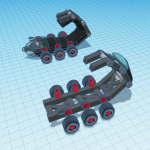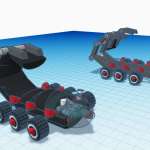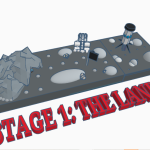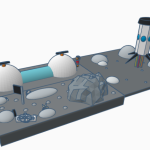Broadcasting research antenna on Mars – Antena emisora-receptora de mediciones sísmicas en Marte by MVP
San Cernin Pamplona-Navarra Spain 16 years old 3 / 0 Spanish Mars
External link for Tinkercad 3D design
Project description
AUTORES: PABLO, JAVIER, XUAN
Características principales
Nuestro proyecto consiste en una antena hecha de titanio en Marte, con un bloque de cristal en la punta que recubre el dispositivo encargado de mantener un sismómetro parecido al que llevaba la misión InSight de 2018 a la parte interior del planeta para descubrir lo que esconde ese planeta por dentro.
Para que la señal llegue más lejos , el dispositivo tiene un repetidor de señales muy ligero, que se moverá aprovechando el flujo de los vientos a lo largo del día, aunque sabemos que el viento es débil. Cabe recalcar que todo el material estructural que le da soporte a las antenas, a la base y a la fuente de energía está en su totalidad hecha por titanio. Ya que este material dota de una resistencia muy grande a la presión y a la temperatura, ya que este soporta hasta los 250 MPa y desde -220 hasta los 1688 grados centígrados, y la presión de marte es de 397 Pa y temperatura desde -153 a 253 grados centígrados.)
La antena es capaz de recibir las señales al igual que las manda, por tanto, no es necesaria una segunda antena.
Cómo conseguimos la energía
Conseguimos la energía para potenciar la antena y el hangar a través de paneles solares ya que Marte tiene los mismos ciclos solares que la Tierra (dia y noche)
English translation
AUTHORS: PABLO, JAVIER, XUAN
Main features
Our project consists of an antenna made of titanium on Mars, with a glass block at the tip that covers the device in charge of maintaining a seismometer similar to the one carried by the 2018 InSight mission to the inner part of the planet to discover what that hidden space planet inside.
So that the signal goes further, the device has a very light signal repeater, which will move taking advantage of the flow of the winds throughout the day, although we know that the wind is weak. It should be noted that all the structural material that supports the antennas, the base and the power source is entirely made of titanium. Since this material provides very high resistance to pressure and temperature, since it withstands up to 250 MPa and from -220 to 1688 degrees Celsius, and the pressure on Mars is 397 Pa and temperature from -153 to 253 degrees Celsius.)
The antenna is capable of receiving signals as well as sending them, therefore, a second antenna is not necessary.
How we get energy
We get the energy to power the antenna and the hangar through solar panels since Mars has the same solar cycles as Earth (day and night).
#3D Design
Other Projects
Moon Camp – Semisfere lunari
Rover lunar basados en la biónica Ricardo Frasser
Lunar base as research center



















